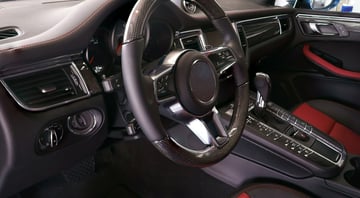Why More New Vehicles Use EPS Today
 The first iterations of electronic power steering (EPS) were introduced to the automotive market in the early- to mid- 1990s in the form of steer-by-wire, so why is EPS such a major topic of discussion in the steering industry today? As EPS technology and design continues to develop, the technology became much more widely adopted and installed by OEM vehicle manufacturers, meaning that rebuilders and shops are seeing more and more EPS-related business, and the numbers are still growing. In fact, By 2020, 92% of new vehicles will use EPS while only 6% will be hydraulic. That's a huge shift in the industry from just a few decades ago, but why is it happening now?
The first iterations of electronic power steering (EPS) were introduced to the automotive market in the early- to mid- 1990s in the form of steer-by-wire, so why is EPS such a major topic of discussion in the steering industry today? As EPS technology and design continues to develop, the technology became much more widely adopted and installed by OEM vehicle manufacturers, meaning that rebuilders and shops are seeing more and more EPS-related business, and the numbers are still growing. In fact, By 2020, 92% of new vehicles will use EPS while only 6% will be hydraulic. That's a huge shift in the industry from just a few decades ago, but why is it happening now?
In short, vehicle manufacturers are installing EPS systems into today's new vehicles in order to provide the features, performance, and driving experience consumers are looking for, and this ultimately affects how your business must service the industry. In this post, we'll explain why more new vehicles use EPS today in order to provide benefits to the consumer as well as what all this means for your power steering business.
Why EPS is Used in Today's New Vehicles
 Following the electrification trend. Across nearly every industry, consumers have come to expect some level of "smart" technology at least available as an option. This is especially true in the automotive industry, where a general electrification trend has resulted in advanced features like smart navigation, audio and visual displays, voice commands and calling features, and more in the cars coming off the production line today. Not only are these new vehicles equipped with electrified entertainment features, however.
Following the electrification trend. Across nearly every industry, consumers have come to expect some level of "smart" technology at least available as an option. This is especially true in the automotive industry, where a general electrification trend has resulted in advanced features like smart navigation, audio and visual displays, voice commands and calling features, and more in the cars coming off the production line today. Not only are these new vehicles equipped with electrified entertainment features, however.
The actual mechanics of the vehicle, including the power steering system, has been electrified over the years, with manufacturers switching from physical parts to computer-driven components. EPS relies on an internal computer that takes road and driver input and uses this data to calculate optimized electronic output that improves performance. This allows drivers to do more in their cars while driving, hands-free, quickly and on the go, matching the pace of modern lifestyles. While not all of today's new vehicles are "electric cars," most models are equipped with more electronic features than every throughout their designs, including the installed EPS system.- Improved safety features. EPS also provides improved safety features that consumers are looking for. Essentially, EPS systems reduce the risk of human error by providing assistance features that correct mistakes and reduce risks caused by distracted driving. Features like auto-braking, lane stability, and blind spot notifications in conspicuous areas like the side mirrors allow EPS to enable consumers to drive safer and avoid accidents. The calculations made by the EPS computer with input from electronic sensors provides a higher level of safety than a hydraulic system ever could with a purely mechanical design.
- The move toward autonomous vehicles. Finally, the industry shift toward EPS is a stepping stone, in many ways, toward the autonomous vehicles we're likely to see on the roads in the near future. Considering all of the entertainment and safety features we've mentioned, manufacturers are using EPS as the transition to an automotive market that puts more of the responsibility of driving on the vehicle rather than the driver. By some estimates, we may begin to see truly autonomous, self-driving cars on the road as soon as 2021. By offering most new vehicles with EPS already installed, manufacturers are essentially allowing consumers to get test-pilot the idea of more autonomous controls, helping ease the transition between traditional vehicles to autonomous ones.
Servicing the Electrified Power Steering Market
 As vehicles with electronic power steering continue to rise in production, hydraulic systems are proportionately disappearing from the assembly line. Manufacturers are eager to provide the driving experience and features that consumers are looking to buy, and all of those trends point back to the more advanced capabilities of EPS over traditional hydraulic systems. This shift presents a huge opportunity for your power steering business, as the vehicles that come in for service start to use EPS much more often than not. While you'll likely still see a few older vehicles with hydraulic systems in the coming years, you can absolutely expect that the ratio will start to lean heavily toward the EPS side sooner rather than later.
As vehicles with electronic power steering continue to rise in production, hydraulic systems are proportionately disappearing from the assembly line. Manufacturers are eager to provide the driving experience and features that consumers are looking to buy, and all of those trends point back to the more advanced capabilities of EPS over traditional hydraulic systems. This shift presents a huge opportunity for your power steering business, as the vehicles that come in for service start to use EPS much more often than not. While you'll likely still see a few older vehicles with hydraulic systems in the coming years, you can absolutely expect that the ratio will start to lean heavily toward the EPS side sooner rather than later.
With autonomous technologies on the horizon, the power steering industry is in a huge period of transition, and in order to stay in business, you'll need to start learning to repair and rebuild EPS systems as soon as you can. EPS represents essentially a whole new business for rebuilders and shops because the nature of these steering systems are very different from the hydraulic vehicles you may be used to. As the technology continues to develop, systems will only become more complex, so it's important to start the transition now while the learning curve isn't quite as steep. Otherwise, you're likely to fall behind the competition and struggle as hydraulic steering disappears from the road.

